LC500 dazzles from looks, power, to top
By John Gilbert
If you were buying a car and could only pick one, would you prefer a high-performance sports car with exceptional power and handling, or a stunning, great-looking sports car that freezes passersby in their tracks every time you drive past?
The answer, of course, is both. And both are readily attainable — for a price. The provider of this spectacular vehicle that combines such mind-blowing attributes is Toyota. Surprised?
Known almost exclusively for steady, durable and intelligent engines and vehicles, Toyota has made inroads into the higher-performance segments in the last couple of years, mostly through its upscale Lexus nameplate. They’ve struck paydirt, with the 2021 Lexus LC500.
That badge has been the ultimate, for Lexus, and the plateau of excellence has been raised on several counts with the 2021 L:C500.
First, beautiful as a coupe, for this year, it’s a convertible. The LC500 is great looking with the top up, as a coupe, but it goes from attractive to spectacular with the holding of a concealed console switch that executes a mechanical coordination of erector-set inner parts, which raise the rear deck, lift off the sleek roof, and nestle it down into the rear compartment before uncoiling the mechanical routine and latching the decklid over the whole thing. It takes about 12 seconds for the process, which means you can easily put the top down at a stoplight. More importantly, if you’ve been driving top-down and avoiding the threat of rain sprinkles, you can put the top back up at the next stoplight in the same brief mechanical flurry to keep you dry.
The test LC500 came in “Infrared,” a sizzling metallic red that reflects every meaningful bit of light back at your receptive eyes. Somehow, convertibles look better in red, and red looks better in Infrared.
Toyota also straddles another fine line to reise above the reputation of being stodgy and using its excellent engines for so long they become outdated. An exceptional engine can stand the test of time, but there is a difference between an exceptional engine and a decade-old exceptional engine.
The LC500 conquers the debate by getting Toyota’s well-proven 5.0-liter V8, with its dual overhead-camshafts and combination direct fuel injection, and it gets new life in the LC500 as a 471-horsepower unit under the hood of the sleek convertible. It gives you all the performance you might have thought was beyond such a luxurious vehicle. Lexus will use that same engine in a couple of other luxury sedans for the upcoming model year, as well.
In the LC500, the engine runs through a 10-speed automatic, and if the power comes on too smoothly, you can use those long, readily-reached paddles on either side of the steering wheel to upshift and downshift whenever you choose. And your choice can be altered by the simple clicking of a console toggle switch that shows you on the instrument panel that you can keep clicking until you get comfort, economy, or sport, or sport-plus. Sport tightens up the steering and suspension, and hold the revs to a higher calling. and sport-plus does it moreso, supplementing the power and handling enhancements with a bold, mellow roar of power.
Toyota advertising has only recently gone onto a campaign to rave about the new-found sportiness of the Camry and the Corolla, by showing drivers cheerfully smiling while virtually street-racing across bridges and around parking ramp circular exits. They’s let their engineering do the talking on the LC500.
As a subtle example, Toyota, which prefers to do everything in-house, has engaged Yamaha to provide and tune the actively adjustable dampers on all four corners of the LC500.
Exceptional bucket seats support you no matter how hard you push that firm suspension, or power around a tight curve, and a thick, grippy steering wheel fills your hands and encourages you to experiment with the handling limits.
If that’s a brief overview of how the LC500 fills both the requirements of power and performance as well as being clearly the best-looking vehicle ever built by the corporation, in my opinion, the other element of such a creation is the sticker price. It is a high, reflective of the theory that technology and refinement costs a lot. The base price is $101,000, and as tested, with all the extra ingredients from 21-inch alloy wheels to the magical top, the sticker says $112,420.
Everybody who asks, flinches at the thought of any car costing that much, which causes me to explain that a lot of high-tech equipment is expensive, and when you get all that is offered on the LC500, it is probably worth the high price.
In the quest for superlatives, save a few for the Mark Levinson audio system, which is a premium device with possibly the best separation of sounds I’ve ever heard in a car, or in-home unit. It plays through a 13-speaker surround system that gives you radio, satellite radio, Bluetooth, MP3, and even a CD player. We folded my older son and resident audiophile, Jack, into the very tight, very small rear seat — at his own choosing — and as we drove all over. Up the North Shore and later down to St. Paul to the Minnesota State Fair, as well as catching one of the closing weekends at Gordy’s Hi-Hat Drive-In in Cloquet, and on every jaunt we marveled at how fantastic the sound system was.
These days, a lot of performers rerecord their top tunes onto new albums, for contemporary updates to established songs. Several times we wondered if we were listening to new versions of old songs, because of newly discovered background guitars, for example, and later realized we were not. We were hearing all the sounds that had been previously obscured or suppressed by lesser sound systems, including in our home, now isolated and featured by Mark Levinson, whoever he is.
That is not to say everything is perfect in the LC500, even at its steep price. The long console has a palm pad to ease your use of a fingertip mouse panel that you use to summon up all the various controls on the center stack’s 10.3-inch display. But it often was reluctant to respond promptly to my fingertips, and other times it seemed hyper. Frequently, both extremes came together, such as when I was trying to scroll up to reach a certain satellite radio station, and after going up, up, and up, suddenly it would switch to AM. Maddening. If we owned the car, I’m sure we’d get used to its idiosynchracies, but as it is, every time we wanted to tune the radio it was a source of frustration.
The climate control was a similar puzzle of mouse-ramblling that was complex. I worked for 20 minutes to kill the seat-ventilation that blew chilly air through the perforated backrest of my seat when it was not needed, and after solving it, a few minutes later my back was scorched because the system had switched from cooling to heating, unintended. Again, I would get used to it if I owned the car, instead of just turning it off and not using it any more during my weeklong test.
The latest news from JD Power, by the way, tells us that the latest Initial Quality survey of new cars calculates the nuisance factor of adjusting electronic controls right along with power, performance, handling, comfort and convenience attributes of a new car. Personally, I don’t think that’s appropriate. If an aftermarket company installs an audio, climate control, or cell-phone connectivity system that is needlessly complex, I don’t think it should detract from a new vehicle’s operation.
My suggestion to JD Power is to exclude the audio and connectivity controls from all the other new-vehicle operations in the equation, and then conduct an entirely separate poll to determine the best and worst operational processes for a separate ranking.
With the LC500, there is an easy solution. Put the top down, switch to Sport, and then turn the climate control and audio system OFF as you drive off over the horizon to the tune of that mellow exhaust note — poorer, maybe, but well-satisfied.


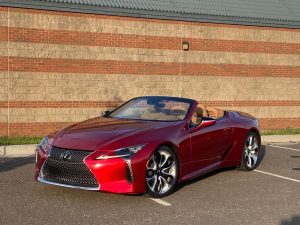
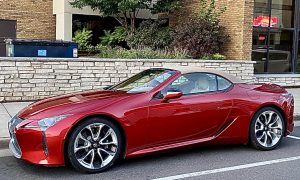
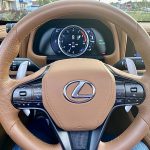
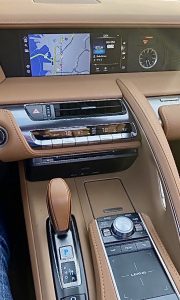
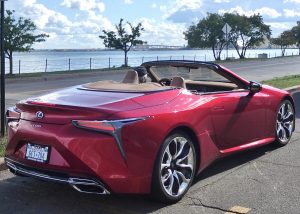
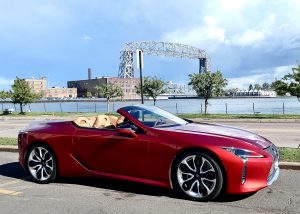
 John Gilbert is a lifetime Minnesotan and career journalist, specializing in cars and sports during and since spending 30 years at the Minneapolis Tribune, now the Star Tribune. More recently, he has continued translating the high-tech world of autos and sharing his passionate insights as a freelance writer/photographer/broadcaster. A member of the prestigious North American Car and Truck of the Year jury since 1993. John can be heard Monday-Friday from 9-11am on 610 KDAL(www.kdal610.com) on the "John Gilbert Show," and writes a column in the Duluth Reader.
John Gilbert is a lifetime Minnesotan and career journalist, specializing in cars and sports during and since spending 30 years at the Minneapolis Tribune, now the Star Tribune. More recently, he has continued translating the high-tech world of autos and sharing his passionate insights as a freelance writer/photographer/broadcaster. A member of the prestigious North American Car and Truck of the Year jury since 1993. John can be heard Monday-Friday from 9-11am on 610 KDAL(www.kdal610.com) on the "John Gilbert Show," and writes a column in the Duluth Reader.